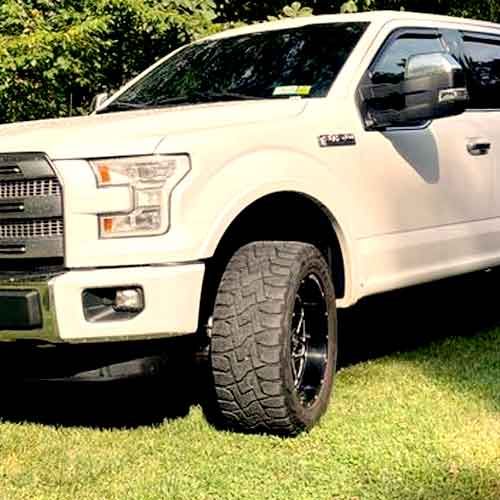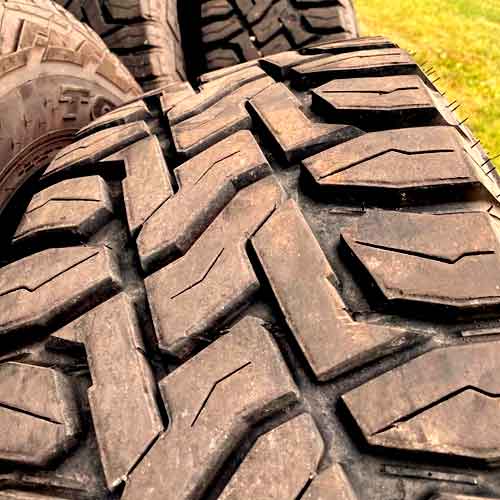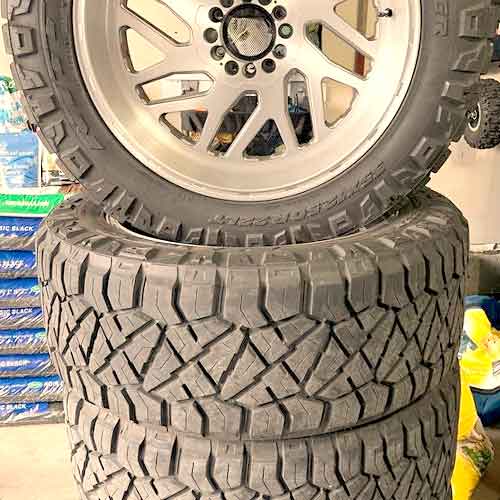Both the Nitto Ridge Grappler and the Toyo RT are considered rugged terrain tires, and that’s what R/T stands for. These tires are also labeled as a “hybrid”, which means they provide a mixture of all terrain and mud-terrain tires’ features in their tread design, where shoulder lugs mostly look like taken from M/T while the central lugs from A/T.

Being a tire engineer, from my perspective, the Nitto Ridge Grappler offers a better traction on rocks, without any doubt, where it may compromise slightly in comparison on sand and mud. On roads however, the tire offers a better responsiveness on both dry and wet. The Toyo Open Country R/T on the other hand, is not so great on wet, is just fine on dry. The tire makes less on road noise, gives you a longer lasting tread as well as fuel economy in comparison. And all this without lacking behind too much off road.
Detailed review of Nitto Ridge Grappler: https://tiredriver.com/nitto-ridge-grappler-review/
Detailed review of Toyo Open Country R/T: https://tiredriver.com/review-of-toyo-open-country-rt/
Table of Contents
Important Sizes Info
Toyo Open Country R/T
Starting with Toyo R/T the tire comes in 15 to 24 inches, where all sizes have speed rating of T and Q, whereas the load rating is offered in a wide range, SL XL, C, D, E, and even F.
So the weight of the tire also varies from 43 lbs to 100 lbs.
Tread depth of the tire stays in between 13 and 19, where mostly sizes have 18.9/32″.
And the tire comes with 45k miles warranty.
Nitto Ridge Grappler
The Nitto Ridge Grappler offers sizes in 16 to 24 inches (Total of 98).
They have similar speed and load ratings compared to Toyo RT, and the tire also weighs a little less as well, going from 36 lbs to 91 lbs of the heaviest size.
However the tread depth is seen less here, where most sizes get to have 16.4/32″ (maximum goes up to 18/32″).
Tread Appearance
Starting with Toyo Open Country R/T, the tire offers interlocking L shaped lugs in the middle.

These lugs provide most of the directional traction in the middle and although they block the longitudinal grooves, they still connect the shoulders by making lateral grooves in between.
Very minimal siping is seen on these lugs, so it’s obvious why this tire is not as capable for wet traction, though hydroplaning resistance is not an issue.
But the siping on the shoulder lugs is still somewhat better, as it’s slightly thicker and more interlocking.
These shoulder lugs are also optimized for off road use, as they offer wide surrounding tread voids, and staggered edges towards the sidewalls.
Though the sidewalls don’t offer thick enough sidewall lugs in comparison.
On the other side, the Nitto Ridge Grappler provides dual sidewall design, where each side gets to have more biting power.
So when you air down these tires, they work like a charm on rocks.

They join the staggered shoulder blocks which run in pairs and are surrounded with stone ejectors.
Also note how similar the siping pattern is on these lugs (compared to Toyo R/T).
Though it’s not that effective on both tires, as with minimal design and no tread features, they don’t provide enough biting friction on wet surface.
But things are very different towards the middle.
Here the tire makes triangular ribs making X and Z shaped grooves, interlocking with each other.
All these ribs have offset edges, full depth siping and notches and reinforced foundations underneath them.
So they offer pavement traction in both wet and dry conditions, as well as off road bite on all sorts of terrains.
Though compared to Toyo Open Country R/T, the grooves voids are not as wide.
Durability
RT tires are tough as they have isobutylene (halogenated) rubber with silica additions, so they get to be soft and at the same time cut resistant as well.
Now here both tire are very solid as they provide 3 + 2 + 2 ply construction, which means you get 3 ply polyester (3 ply sidewalls), 2 layers of steel belts and 2 more layers of cap plies (cap ply sit right below the tread’s rubber)
So both tires are pretty tough. But which is still more tough still?
Well, Toyo R/T offers a harder rubber and it has thicker tread, going up to 19/32″, whereas Nitto Ridge provides up to 16.4/32″, so it’s stronger from the middle.
But Nitto Ridge Grappler is tougher where it matters the most, the sidewalls (as they face the sharp encounters), so here the tire offer thicker lugs in comparison which protects.
Ride Quality
The balder the tire, the limited the ride quality, that’s the rule, now here both tires are pretty bald, so they both are so great compared to less aggressive tires like all terrain, though they are still better compared to mud-terrain tires, that’s why they sit in the middle with their hybrid design.
This is because ride quality has two dimensions, noise and comfort, and with aggressive tires, these factors are compromised.
Let’s check them out in detail.
Noise
Being a tire engineer, I can assure you noise is very tough to understand, luckily you have come to the right place. So here I am going to save you some time without describing tread spectrum, resonance frequency, rolling noise factors and so on…
Out of these two tires, the Toyo RT is better, as it offer better pitch sequencing and it’s as most of noise (air) get though outer shoulder gaps, the sharp middle lug with edge placement there dampen the noise level a lot by one, restricting the air movement, and two, creating variable tones (which is called pitch sequencing).
The Nitto Ridge Grappler has lugs which are more acoustic, meaning sound waves bounces off it’s tread much easily, so it’s louder here, generating more tread noise of higher decibels.
Ride Comfort
Except for the suspension, the tire also plays a crucial role in overall comfort quality, so here tire’s construction has to be considered.
The rubber composites tell how much mechanical energies are able to dampen down, and here Toyo Open Country R/T lags slightly with it’s stiffer compound.
So with inflexibility it’s tread is hesitant of compress and stretch and so the on road bumps don’t get blended and dampened within the tire.
On the other side, the Nitto Ridge Grappler although has a stiff internal cap ply, the spongy layer of it’s tread is quite able to absorb the shocks of uneven pavements with better efficacy.
Off Road Traction
Off road things although get though, it’s not a problem for a rugged tire, as they can go anywhere, even on one of the most challenging terrains, mud.
Rocks
On this terrain the Toyo R/T is very impressive, in fact, at first, I was kinda confused on choosing the best tire for rocks.
I was down to these options.
- Nitto Ridge Grappler at the top.
- Mickey Thompson AT as 2nd.
- And Toyo RT with a very close margin got to be in the 3rd place.
Nitto is the best no doubt, the the Mickey Thompson Baja Boss A/T, comes 2nd, review it here.
And although the Toyo Open Country R/T is third, it doesn’t not mean it’s not good enough, it’s very great. In fact it’s directional traction is superior of them all, but the tire only lacks behind due to it’s less aggressive sidewalls.
Nitto Ridge Grappler with thicker lugs and dual sidewall design offer better biting power, with lowered air pressure.
Mud
On mud you need a tire which can let things off it’s groove faster. So in rugged terrain tires, although they aren’t so great compared to Mud tires, they are still okay overall, meaning if you are skilled, there is a very less chance you’d get stuck.
Here Toyo R/T offers nice voided baldness so the tire offers a good path for mud to leave, however, as its longitudinal grooves are blocked by its central lugs, mud is still somewhat resisted to leave out, when you compare the tire with Nitto Ridge Grappler.
That’s because the Nitto Ridge has X and Z shaped grooves which are interconnected with each other and the shoulder gaps as well, so mud has everywhere to go, as it leaves out sideways.
It’s bigger sidewall lugs also act as powerful mud scoops.
Sand Traction
On sandy terrain, you need a paddled tire, which is light weight and can offer a larger footprint with lowered pressure.
Now here both tires are heavier so that’s out of the picture.
But with softer rubber and bigger lugs, the Nitto Ridge Grappler provides better tread print exposure with the sand, so things are better here overall.
Toyo Open Country R/T is a stiff tire so you’d have to lower the pressure down further, and that’s not recommended, as the tire does not have a stronger rim lock in comparison as well.
Highway Performance
On streets, there are a few things to keep in mind, the tire’s communication with the steering, lateral traction and directional grip.
Let’s talk about them all one by one.
Tire Feedback
The steering response is the way in which your vehicle responds to steering input. It’s measured with the handling quickness.
Here the Ridge Grappler is slightly better as it offers better values with directional stability, and while turning, the tire provides less over-steering.
The Toyo R/T on the other side, is good enough for a Rugged tire, but with slightly more weight, the tire lags here.
It’s heavier 3 ply casing feels harder on higher speeds, and the time between the inputs and response is larger in comparison.
Dry Grip
Dry grip is directional proportional to the exposure the rubber makes with the pavement.
Here the Toyo Open Country R/T offers a pretty straight forward design in the middle so it’s directional grip is better.
Middle lugs make the most contact with the road, and Toyo R/T with minimal tread features offer that, so grip becomes better here.
The Nitto Ridge Grappler on the other hand, offer less area of exposure with the surface, so it lacks here, though the difference is very small.
Dry Cornering
For handling shoulders are considered as they make the most contact with the road when turning.
Toyo R/T is not so great in this area, as the tire is balder form it’s sides.
The Nitto Ridge Grappler is a lot better with it’s paired blocks and foundation supports, so blocks stay firm and offer more rubber to surface meetup.
Wet Performance
On wet always look for two things, wet traction and hydroplaning.
Let’s start with traction.
Wet Traction
Here the sipes and rubber make up is seen, and considering these factors, it can be seen that the Nitto Ridge Grappler is better here.
The Toyo R/T has a rigid rubber, so it’s sipes (which are also not a lot), are not flexible to move and suck in the water to clear off it’s path.
Nitto Ridge is opposite, so it wipes away water in a better way.
And yes, it’s also helped here with hydroplaning.
Hydroplaning
Hydroplaning has to do with water evacuation, the more the better, so Nitto Ridge Grappler with its interconnected Z/X shaped grooves offer faster water escaping.
So the faster the water leaves, the less sipes have to work.
So overall wet traction is improved as a result.
The Toyo R/T on the other hand (consider the tread pattern above), blocks it’s grooves with it’s L shaped lugs.
Snow Performance
Both tires are not 3 peak mountain snowflake rated, but that only means that they can’t perform better when it comes to packed snow, and yes they are a bad idea for ice.
But these tires can still work with deeper snow, and here Nitto Ridge is again better as it’s spongy rubber won’t freeze up as much in comparison (that’s why winter tires are softer).
Tread Wear
Tread wear had a lot of dimensions but the most important one is rolling resistance and tread composition.
The Toyo R/T is better, its harder rubber is more resistant to wear, despite it being heavier off the two.
That’s why the tire offer 45k miles warranty.
The Nitto Ridge Grappler with softer rubber wears off faster and it’s less tread depth is also not helping.
The tire also does not offer any warranty here as well.
To Conclude
Both tires are a great option overall in the rugged terrain category.
But some areas are seen better on Toyo Open Country R/T like on dry roads, with directional traction, noise reduction, fuel efficiency, tread life.
On the other side, the Nitto Ridge Grappler is better suited for rocks, mud, and even sand, it’s also better in terms of hydroplaning off the two, and although it’s a little louder, its better able to soak up the vibrations both off and on roads.